This blogpost was updated on Feb 27th, 2025, with more information thanks to Veronika Wuycheck, the calligrapher who designed the contract in Nosferatu 2024! You can follow her on Instagram or find her website here, where she has lots of high quality photos of her work on the movie. Any new information is marked clearly throughout this blogpost.
Thanks to Veronika reaching out to me, I was able to learn a lot more about the other calligraphy work that went into this film. It was a major oversight in writing this blogpost to not look up who actually created the beautiful artwork I was gushing over, so I'm really grateful to be able to put names to the work! I'll talk a bit more about some other calligraphy work on Nosferatu at the very end, but you can click here to skip right to that new section.
So I saw the new Nosferatu film the other day and while I didn't think it was all that fantastic (I loved the first half okay, calm down) the one thing that did stick out to me was the absolutely gorgeous scripts used for the contract that Thomas has to sign. Thank you to this Reddit post for sharing a picture of the entire thing:
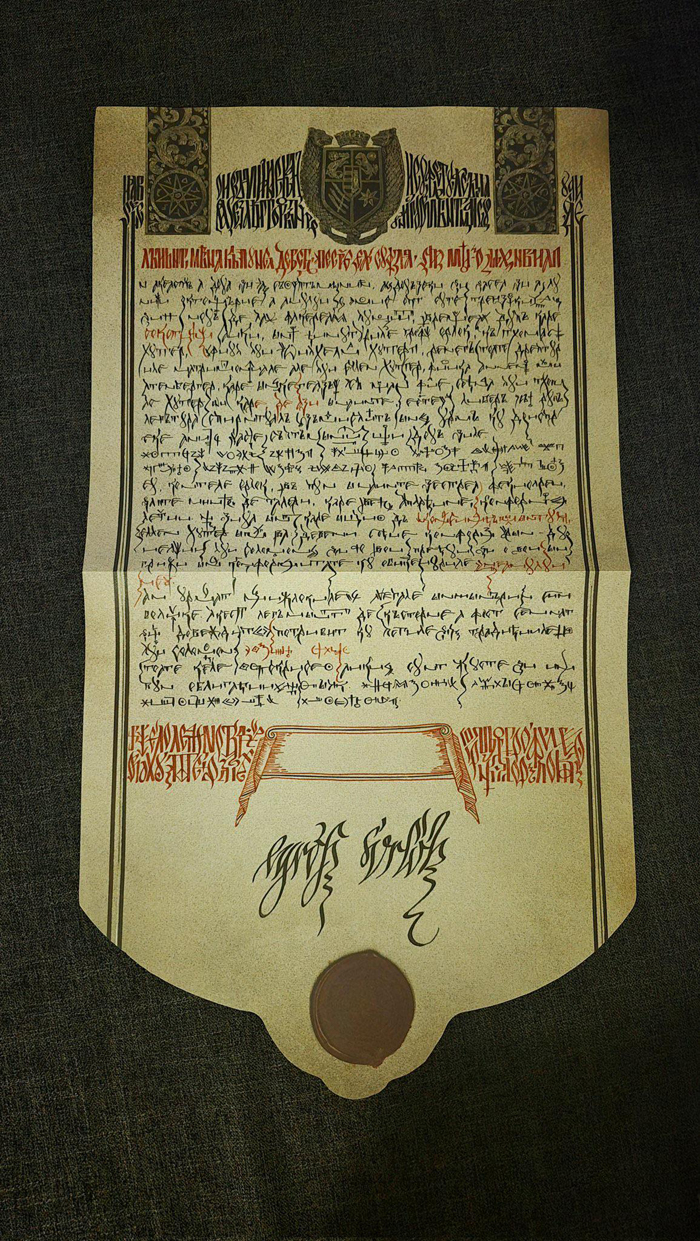
The BEAUTIFUL red calligraphy is called Vyaz, a form of decorative Cyrillic calligraphy. In Vyaz script, letters are all joined and interwoven together to create a beautiful, ornamental typographical piece. The Wikipedia page about it is fucking pathetic but it does feature this example of text with a coloured breakdown of the individual words that comprise the piece:
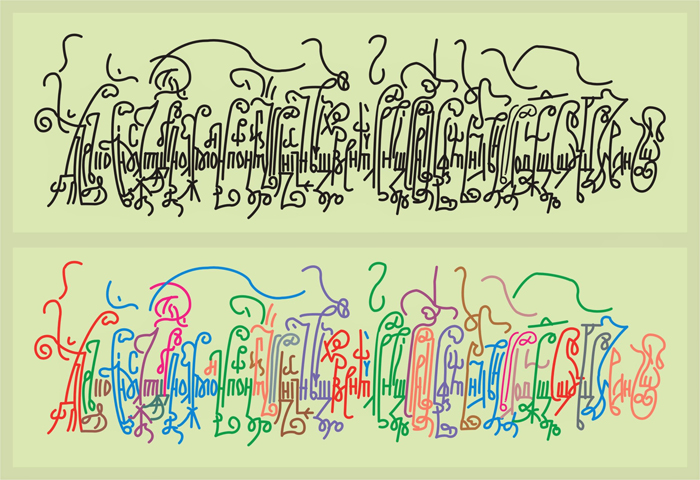
Obviously this itched my language brain like crazy. The best resource I have found since to learn more about Vyaz is this full, free guide written by Viktor Pushkarev. He has also released a 254 page PDF for 25 euros called the Modern Slavic Vyaz Calligraphy Workbook and I think I'm going to have to buy it. His examples look stunning and I would love to learn more about this style of calligraphy. Thank you, Nosferatu.

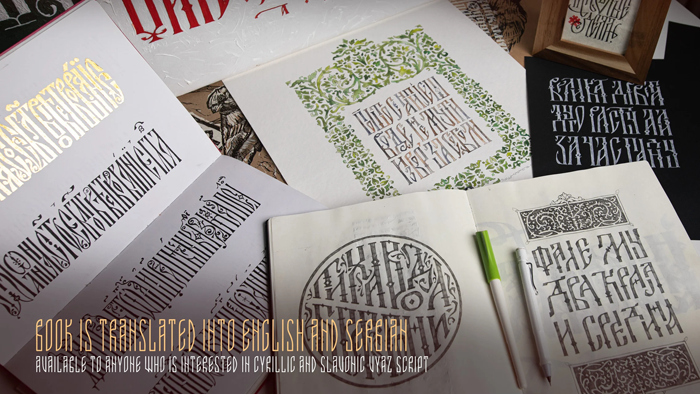
Update: The calligrapher who created the contract, Veronika Wuycheck, went through "multiple versions of the coat of arms, the layout, the scripts used... And tens of iterations of Orlok's signatures, until it was just right [...] Gothic was in the inspiration, but I worked a lot with what the broad nib [a kind of pen] "allowed" when it came to the form" (X). There are much clearer images of the contract, as well as some detail shots, on her website.
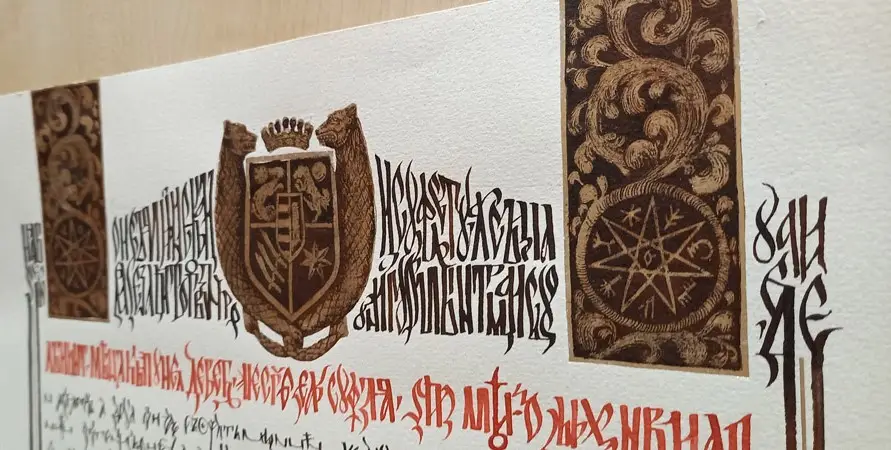
Veronika also told me that the Vyaz title had some runes mixed in: "The runes were specifically Slovak agricultural runes, which were used for the contract in the OG Nosferatu (1922), and then also some random made-up runes I wrote along the way to make it a bit more interesting." I'll talk a bit more about those agricultural runes after the section where I go over the original film's contract; click here to skip right to it.
As an aside, Viktor's Medium page has a lot of related articles on Slavic typography and other related arts. And ohhh fuckkk you're not going to believe this, but I just found his website.... and it has fonts for sale. Oh my god.
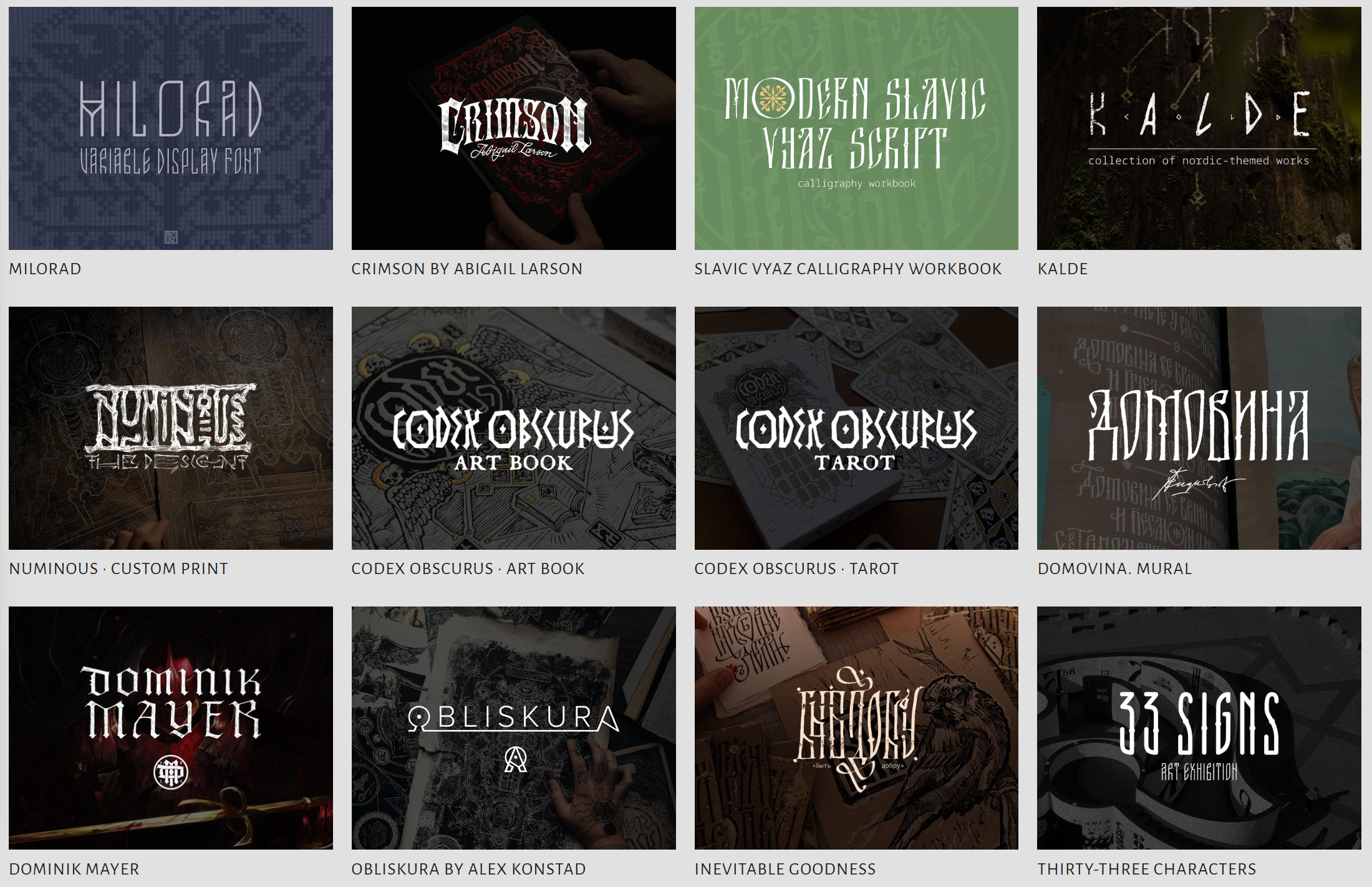
Okay, okay. I'm going to have to do more of a deepdive into Viktor's articles and work in my own time. Let's get back to Nosferatu. But like, specifically the contract.
The Vyaz calligraphy is only one style of writing used in that contract. The other is a completely different style of writing and, surprisingly (or not, maybe?) the best place to look for answers turned out to once again be Reddit. This commenter suggests it's another form of Cyrillic:
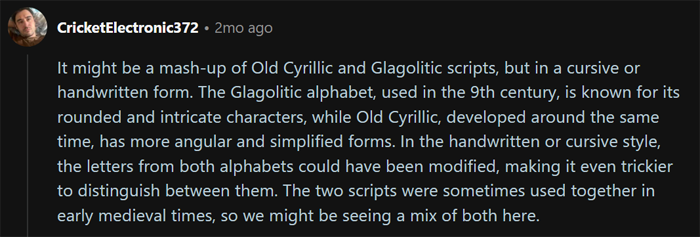
Here's some Glagolitic, to compare:
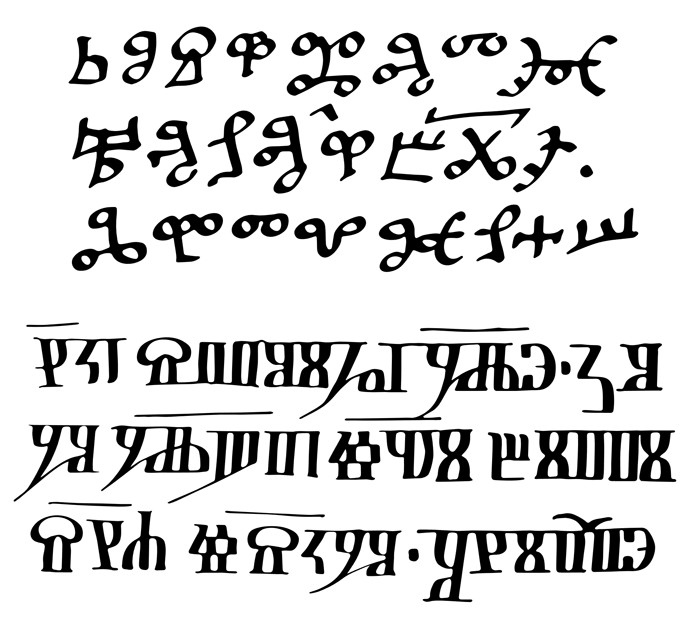
Update: Veronika confirmed the main body of text was written in "a free-hand version of old Cyrillic script with agricultural runes mixed in" (X).
In a different thread, this commenter claims to have cracked it:
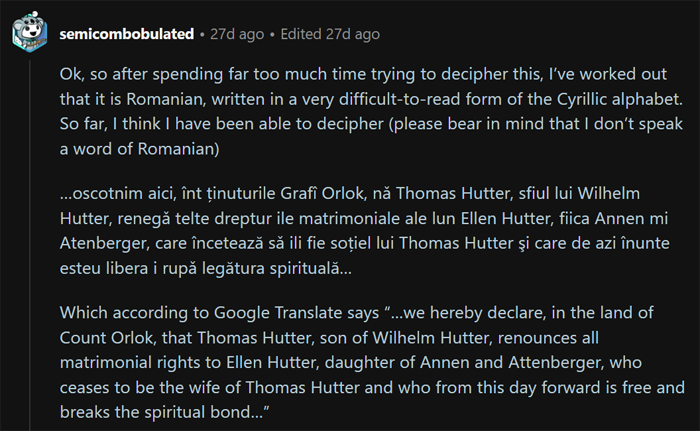
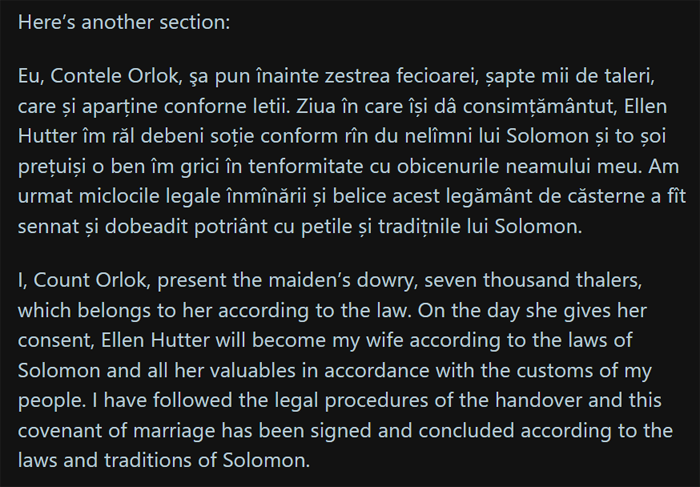
This commenter replies with an addition:
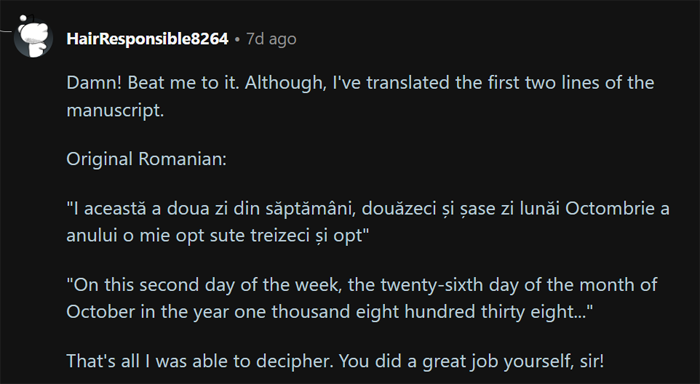
So that's cool! In that same thread, this commenter says that the contract looks like a Romanian hrisov, or medieval chancellery charter, and recommends this video explaining how they were written. As you can see from the example below that the commenter shared, these traditional contracts look pretty damn similar to Orlok's contract! So let's talk about them real quick, because it's interesting!
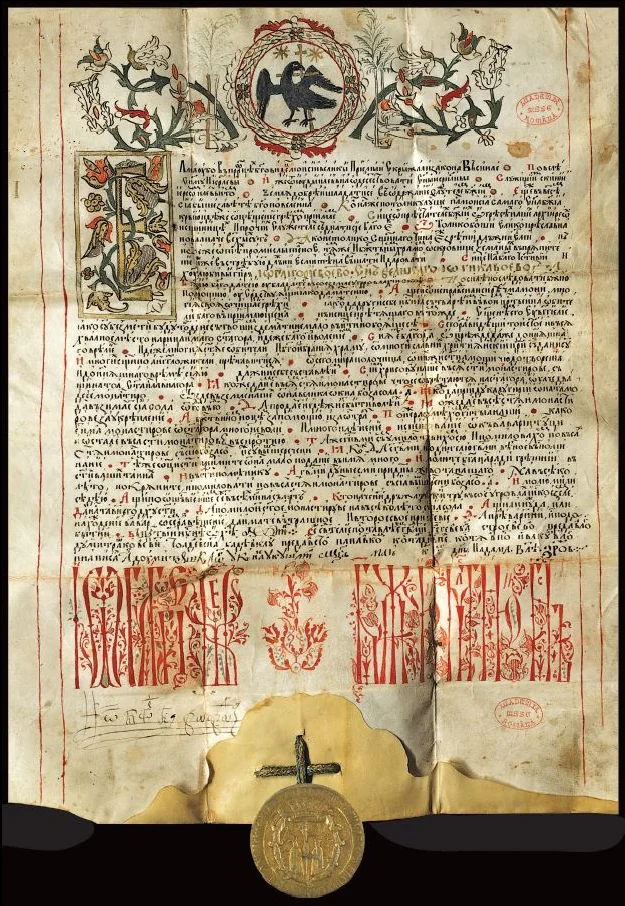
The video is by Adrian Gheorghe, a historian whose speciality is the editing and translation of all documents regarding Vlad the Impaler. He talks about how unlike letters, which would be written in Latin, these charters were written in Slavonic, a liturgical and "literary language, based on Slavic dialects of the Balkans, developed by monks in the 9th century" (X). Viktor Pushkarev suggests a book called Grammar of the Church Slavonic Language if you want to learn more about the grammar and syntax. Slavonic was often written in Glagolitic and hey, we've seen that before!

These charters also had explicit and strict structures that they adhered to. This strict standard served to not only prove the legitimacy of a document, but that "the document was drawn up with all due solemnity" (X). Interestingly, each charter would invoke God in the opening lines or would simply have a cross at the beginning, and according to the translations given above Count Orlok's contract does not seem to include this. I recommend checking out the video in its entirety to hear more about this cool bit of history.
Update: Veronika confirmed to me that the contract's layout was inspired by historical contracts, though "the brilliant colouring of those was dropped in favour of Eggers' colour scheme chosen for this film".
But of course... that's not all that's written on the contract, is it? Thomas signs it, and he signs it in Kurrent script, an old traditional form of German cursive. If you'd like to learn how to write in Kurrent, there's a free guide by Margarete Mücke right here! Here's a screenshot I took of the scene along with a Kurrent alphabet for comparison:
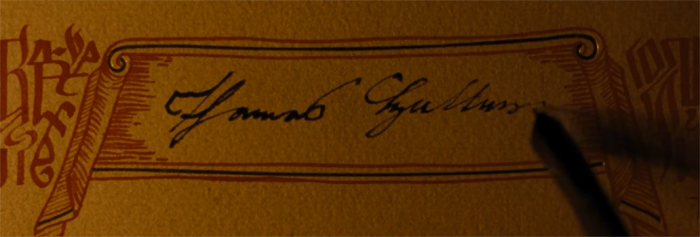
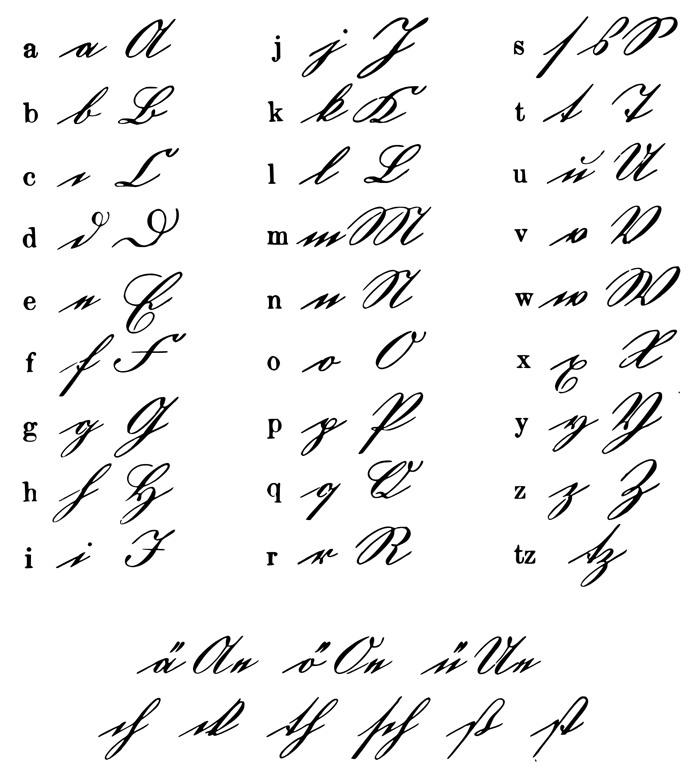
Update: Veronika did not create Thomas' signature - that was her colleague Ladislav Kouba, another calligrapher working on the film (X). Since we can see the signature being drawn, I assume that's actually Ladislav!
Kurrent has a really interesting history. It evolved from gothic cursive at the beginning of the 16th century, which saw a lot of use in the medieval ages. Compared to the vast variety of gothic cursive writing styles, Kurrent was "beautiful, fast to write and comparatively legible" (X). It soon moved out of use solely in chancelleries and into everyday use, becoming more and more standardised.
This script saw a bit of a rollercoaster of popularity; in the early 1900s it was established and taught in all German schools, then steadily became seen as "antiquated and ugly", then the Nazis declared other writing scripts "Un-German" and promoted gothic typography until 1941 when Hitler declared Kurrent and its sister writing style Fraktur "to be of 'Jewish origin' and therefore taboo". More information about this can be found on this page about the history of Old German Script (another name for Kurrent).
So that's that! Count Orlok's contract is based on traditional charters of the region with set structures to highlight their legitimacy and importance as documents, using traditional scripts and handwriting of the time, and is also a style of document that is directly tied to Vlad the Impaler, the inspiration for Dracula and ultimately Nosferatu. Extremely cool and also totally makes sense considering Robert Eggers' interest in authentic linguistic detail (like I didn't even mention the language that Orlok speaks throughout the film, which is Dacian, an extinct ancestor of Romanian). Lots of really tasty stuff to look at and I had a blast putting it all together.
Update: There's merch featuring the 2024 contract??!! Someone has to buy me this. Send me money.
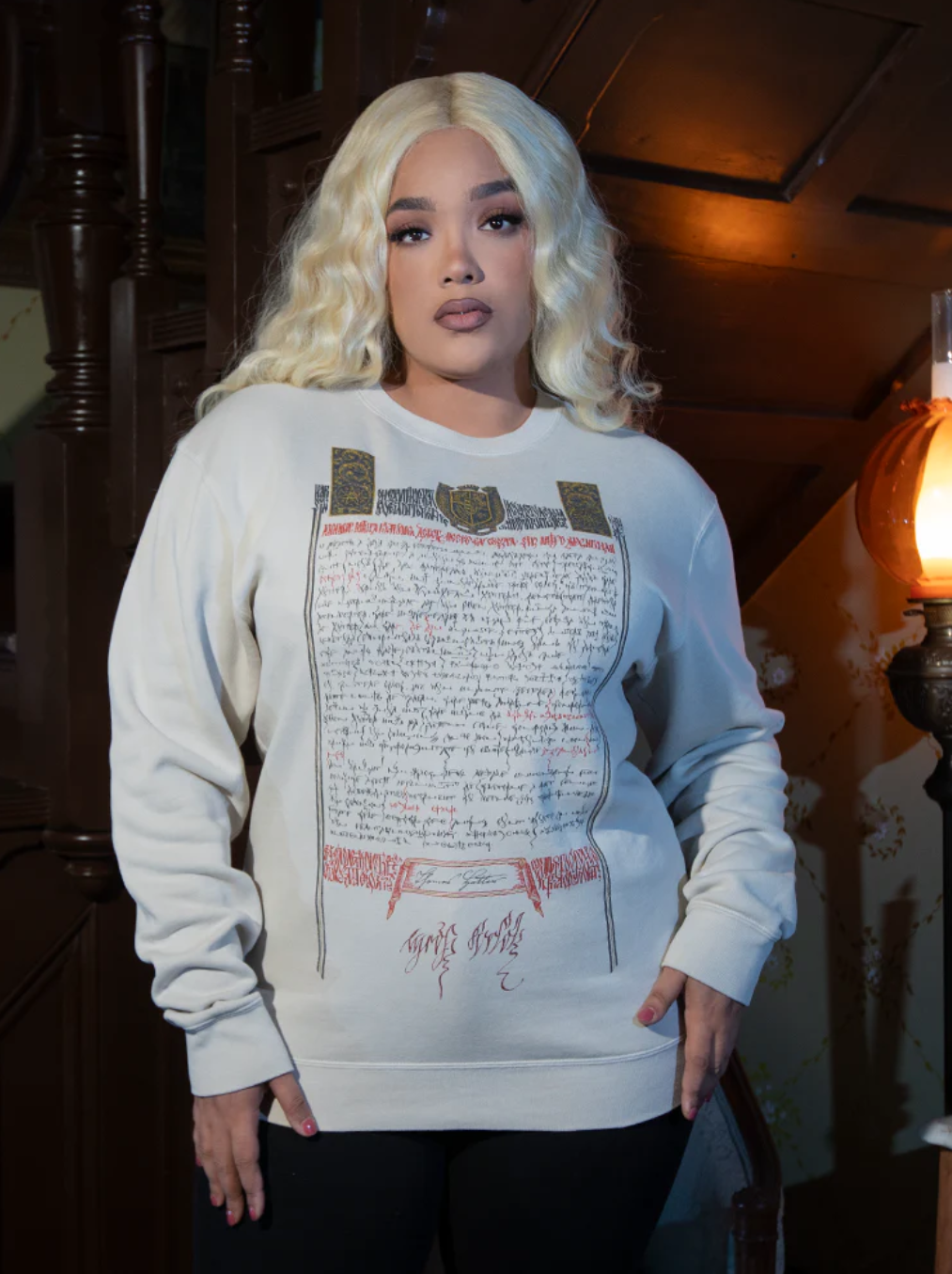
Dude come back, we're not done talking about this contract. While searching for answers on what those scripts could be, I came across someone saying that the contract in the original movie was written in Enochian, a conlang I had literally only heard of for the first time the day before, so that was weird. Let's talk about Enochian now! :)
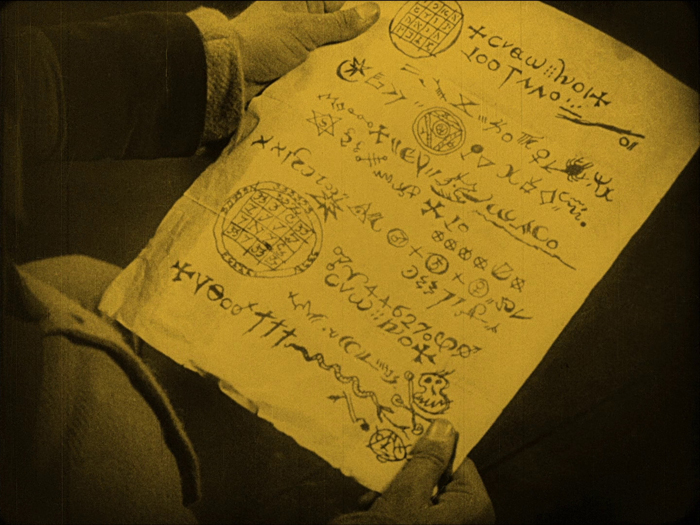
Enochian is an invented language from occultists John Dee and Edward Kelley, who claimed to have been given knowledge of the language from angels. The language is named after the biblical character Enoch, who supposedly was the last known human to use the language. Dee also believed this was the language spoken by Adam. I guess Eve kept to herself.
Together with Kelley, Dee claimed to have communicated with angels hundreds of times and recorded Enochian alphabet and grammar, transmitted through a scrying stone. He also received a series of prayers, also known as "keys" or "calls", which make up the bulk of the Enochian language and conveniently came with English translations. I love when a conlang has lore. Here's the Enochian alphabet as channelled by Dee:

...And here's a celestial script from the Voarchadumia, a mid-1500s alchemical text from Joannes Pantheus. As this article points out, there are many similarities between the two; in fact, Dee "owned a copy of Voarchadumia and had annotated it heavily" (X).

As an aside: Enochian has entered cultural knowledge as the Angelic Language and there are believers out there. One supposed gotcha for non-believers is a claim made by writer Gerald Suster, who said "philologists agree that it is impossible for a man to invent a new language", which is just like. That's so funny. No it fucking isn't. And anyway, linguist Donald Laycock pointed out that for the most part Enochian's grammar, syntax, and phonology all match English. It has the same soundset and the same word order. Even languages related to English aren't near identical and it all points to the language being made up by an English speaker. So it wasn't even the most imaginative invented language in the world.
Laycock suggested a more believable alternative to the "language of the angels" thing, which is that the channelled Enochian was just glossolalia, or "speaking in tongues". More info about both of these arguments are available in this very thorough article, but Laycock wrote a book called The Complete Enochian Dictionary: A Dictionary of the Angelic Language Revealed to Dr. John Dee and Edward Kelley and please look at this review of it lmao:

It's a dictionary, madam.
Enochian is super interesting and has a lot of tangents I'd like to talk about, even more than I already have, but let's get back on track. The 1922 movie arose from an era when interest in spiritualism and occultism were on the rise, and producer and dedicated occultist Albin Grau would have been familiar with Enochian as a popular occult concept (X). Looking at Orlok's 1922 contract, we see a couple of Enochian elements. The letters and symbols are the most obvious, but there's more. The top left and bottom left of the page have grids of letters; Kelley purportedly "had visions of great square tables, each with 49x49 squares. The instructions from the angels were that these tables should be filled with letters forming words" (X). Obviously these grids had to be made a bit smaller for Orlok's wee contract but I'm sure this is a reference to that feature of Dee and Kelley's Enochian sessions.
The top left grid, however, also contains some Hebrew letters:
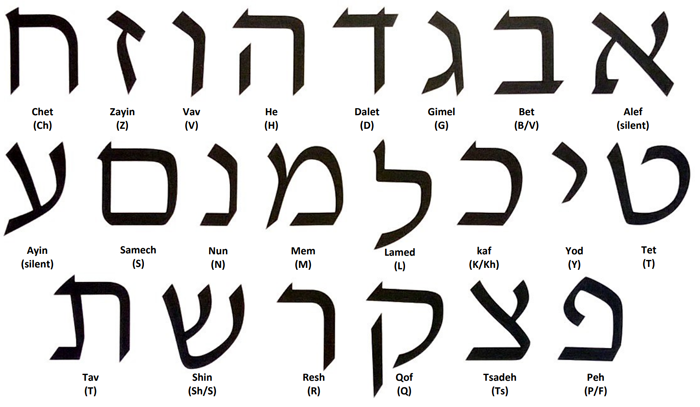
This isn't super surprising; before the rise of Enochian and other angelic language concepts, Hebrew was considered the closest thing to a potential biblical language. After all, the Old Testament was originally written in Hebrew; it's one of the oldest languages on the planet. Another neat little detail to include if you're trying to make your contract look old as fuck. We also have a little Star of David in there.
The last thing I can pick out here is this section:
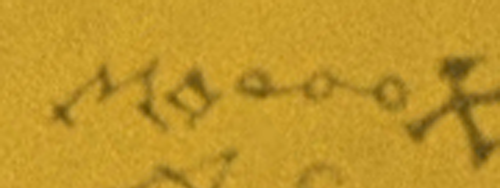
This circles-and-lines symbol looks to me like it could have been inspired by Malachim or another of the celestial/angelic alphabets created by German occultist Agrippa in the 1500s. Here's the Malachim alphabet, for comparison:
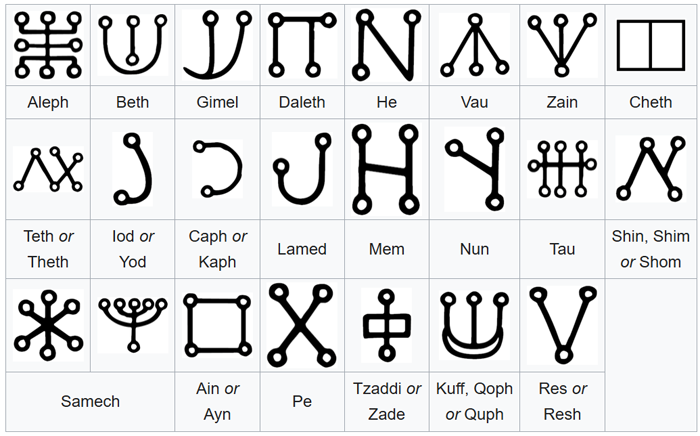
It's not exactly any of these symbols, but Agrippa's alphabets were also circulating as a potential angelic script and were known among occultists so it wouldn't surprise me if that was the intention here. Also, you didn't hear it from me, but this is just a fan version of Hebrew. Compare the names and shapes.
We also see some alchemical symbols thrown in for good measure. Here's what looks like an alchemical equation (Mars + Saturn + Venus):

And here's an overview of some alchemical symbols:
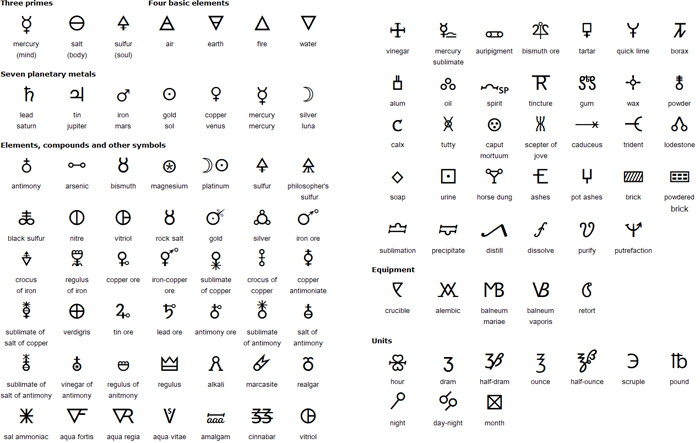
You see a lot more alchemical symbols than you do Enochian, which is really funny to me. This contract is less a legal document and more a recipe.... for love :)
Orlok was also working for Slenderman or something too.

But my favourite part is all the little drawings Orlok did of wee beasties.

Good job, Orlok, we'll put this on the fridge.
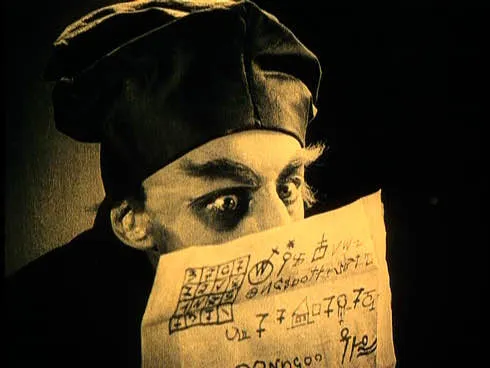
Some interesting things to note: there are 3 crosses at the bottom of the 1922 contract, and the bottom left grid of letters is circled by the repeated number 3. In the bible, the number 3 has great importance and is usually associated with God. I'm stroking my beard over this, considering the 1922 movie states that Orlok was born of the devil: "By the seed of Belial sprung Nosferatu." If Enochian is the language of the angels, it makes sense for other references to also be related to Christianity, but it seems to me to be coming at it from the wrong angle. Furthermore, the bulk of the symbols on the contract do not look to be Enochian to me. I dunno what they are, but I couldn't see much similarity when cross-referencing the contract with Dee's and the Voarchadumia's Enochian alphabets. If any of you know what any of the other symbols could be, give me a shout on social media! I'm curious.
Update: According to Veronika, both the original and new versions of the contract used Slavic agricultural runes. These aren't Futhark runes, the kind everyone thinks of when they hear the word "rune"; Futhark was a Germanic script, not Slavic. The first evidence of Futhark use in the Slavic region was only discovered in 2021 and it is not a full text, just a list of the last several letters of the Futhark alphabet* (X). This was the inscription:
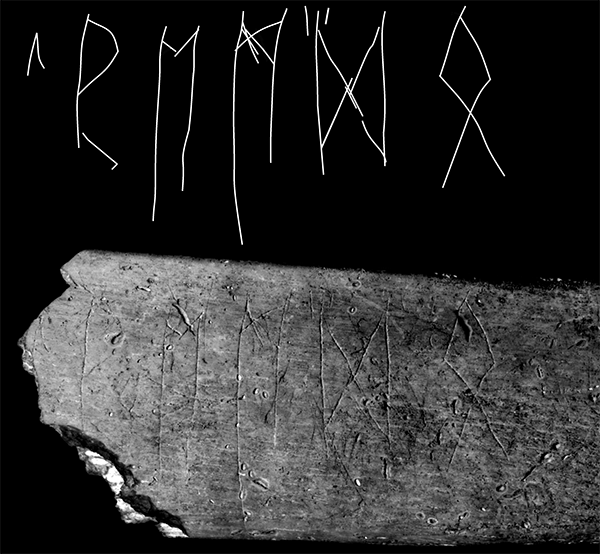
The closest thing I could find to fitting the description "Slavic agricultural runes" is Székely-magyar rovás, or Old Hungarian script. Hungarian is not a Slavic language, it is Uralic, but the Székelys people who used this script did live in Transylvania, now Romania (X).
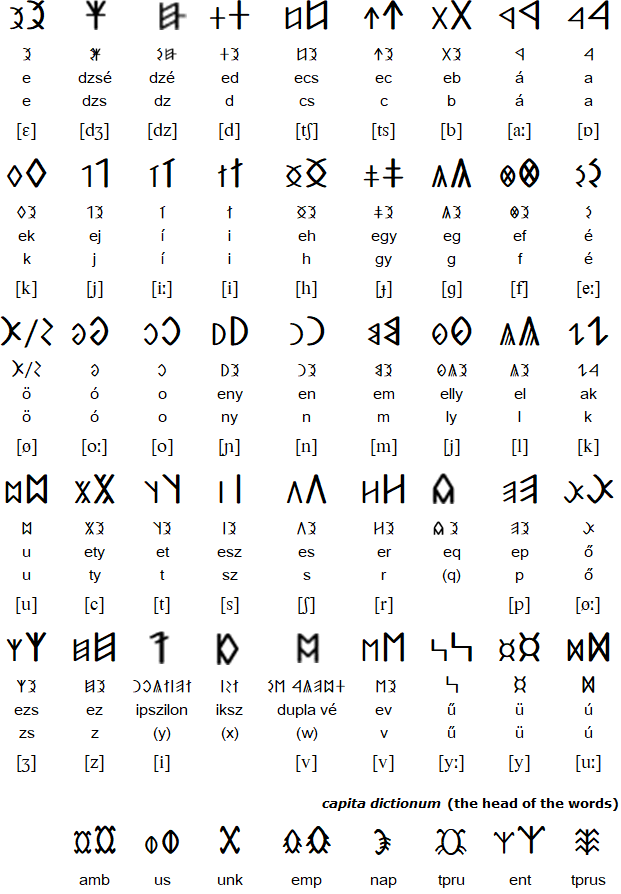
It was interesting to read this article about the Székely runes published in 2010, which goes over how the 20th century revival of the script has led to a proliferation of inauthentic use, like new or updated letters. Most importantly, it specifies that these runes were never used like modern writing: "it was not used to write letters or messages. [...] Where it is used, it is always primarily to show off their education, to indicate that they know this writing – not for practical purposes. Its users are always educated people, priests or masters, which suggests that only a few people have always known it" (X). This is a sort of counter to what other sources mention as uses for the script: shepherds using it to keep track of animals (X), or tradesmen carving their names into bricks or wood (I would link to this source but I think it's a right-wing news site).
It is especially interesting to read this point about the correlation between interest in ancient scripts and right-wingers: "There is no doubt that extreme right-wing circles are specifically interested in runic writing [...] Klára Sándor [a Hungarian linguist] has just warned that if we reject runic writing because of its use by the extreme right, we are precisely helping it to appropriate another part of our extreme cultural heritage" (X). This is something we saw with Kurrent/Fraktur and the Nazis too, and it's the same with Futhark runes and white supremacists. What is it with these nationalist freaks?
As for how the Székely runes relate to the 1922 Nosferatu contract, I can't distinguish any specific runes. They may very well have been a point of inspiration, but I think the contract is in general very poorly made so it's not easy to separate out which symbols are Székely runes, which are Enochian, and which are just made up. It would be much more interesting to go over Veronika's version of the contract and pick out which symbols are potential Székely runes (if I'm actually corect about them being Székely runes that is) - if any of you are up to that challenge, shoot me a message with what you find!
As a final note on Slavic runes - I found lots of lists of symbols that claimed to be "Slavic runes", but these are almost all modern in invention and don't actually have any connection to Slavic folkloric figures or deities. They're cool, but they're not authentic (X) so be wary!
Annoyingly, this Forbes article claims that in the 2024 movie "an occult contract covered in magical symbols makes an appearance". I'm not expecting everyone to be as insane as me and look into every element of one piece of this movie, but it does frustrate me that such purposeful and careful choices are being waved away as just as kooky as the dorky Enochian symbols.
Okay! That's it, for real this time! A big deepdive into all the different inspirations for these very specific contracts in these two specific movies. I had a great time reading about all this and found sooo many interesting articles and research avenues, so I'm sure future blogposts will touch on some related stuff down the road.
In case you missed any of them, here's the full range of external non-Wikipedia or -Reddit links I put in this post that you might want to check out:
- Update: Veronika Wuycheck's Instagram and website
- Viktor Pushkarev's free online guide to Vyaz and his paid workbook
- Old Church Slavonic from The Language Gulper (which looks like a cool overview of a lot of interesting languages)
- On the one true faith: The December 2019 [Old Church] Slavonic item of the month from the University of Cambridge's language collections
- How were medieval Romanian documents written?, a video from Corpus Draculianum/Adrian Gheorghe
- A Guide to Writing the old German "Kurrent" Script by Margarete Mücke
- On the History of Old German Script from The Walden Font Co., a site that resurrects old typefaces
- Update: Runes on rib bone oldest script used by Slavs from The History Blog
- Update: Ancient Hungarian heritage? Humanist forgery? from Nyelv és Tudomány
- Update: Fakelore and istina in Slavic tradition from Witia
- The Occult History of 'Nosferatu', Explained from Forbes
And wacky shit warning:
- Enochian: The Mysterious Lost Language of Angels
- "Enochian" language: A proof of the existence of angels?
- The Tongue of Angels
Update: Veronika detailed a bunch of other calligraphy work she did over on her Instagram and website so I'd like to give her a huge thank you for sharing photos and info. The below work isn't related to the contract but it goes to show just how much detail went into the sets.
Veronika used a variety of tools to create the calligraphy seen in the film: dip pens for most of the calligraphy, pointed pen nibs for any Kurrent script, and paintbrushes for larger pieces (X).
Von Franz's writings
Alongside the many papers that appeared in the film, Veronika also worked on the sets themselves, adding "tens of notes, diagrams and scribbles Von Franz would've written, or [adding] marginalia to graphics Štěpánka Sigmundová and Elena Vatruskina provided" (X). These include all kind of alchemical illustrations and interesting annotations. Von Franz's notes were written in Kurrent, just like Thomas' signature.
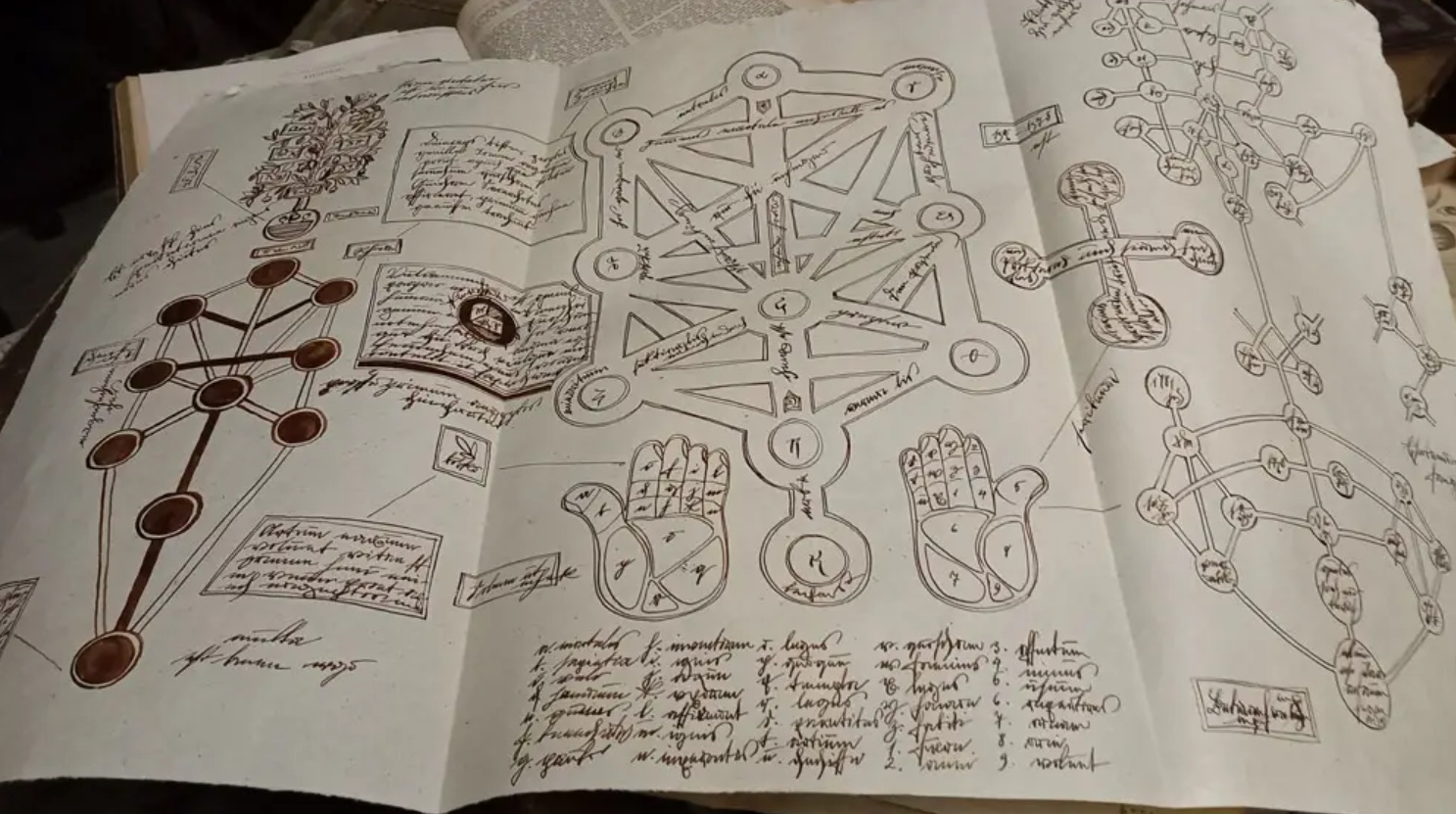
Veronika even drew on the Voynich manuscript for inspiration (X), an undeciphered text from the early 1400s.
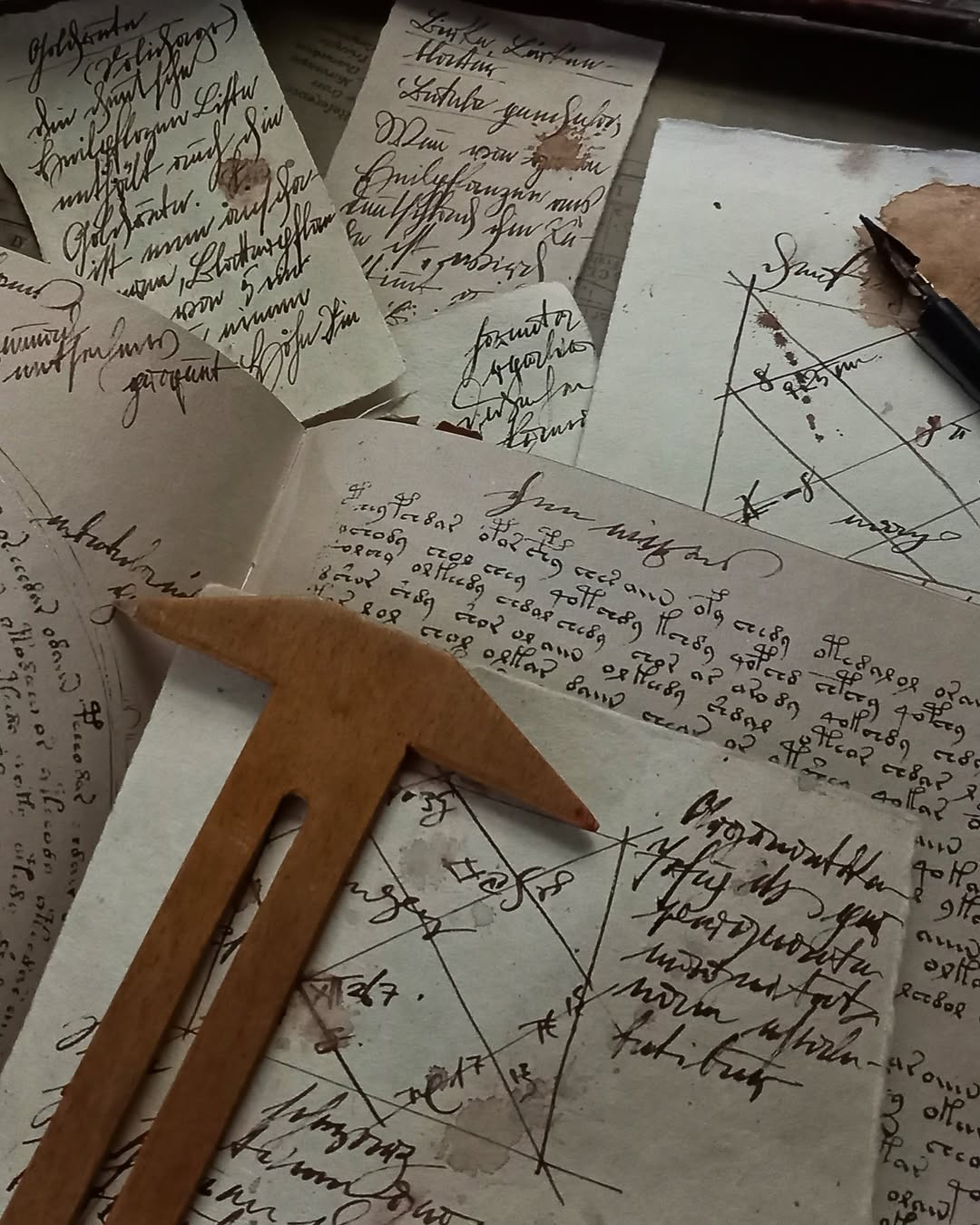
An excerpt from the Voynich manuscript, to compare:
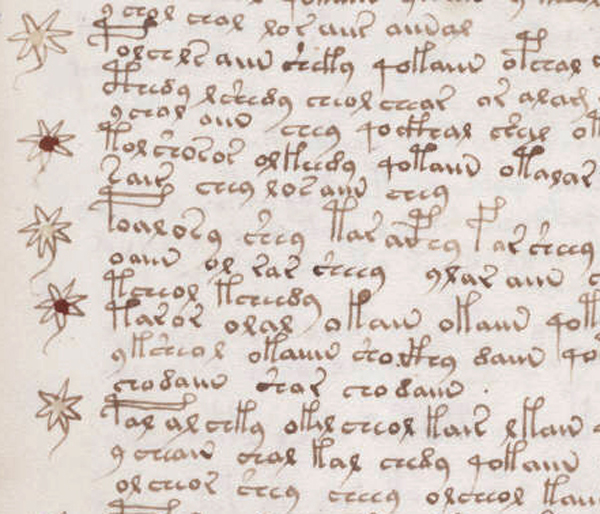
Von Franz's manuscript
The manuscript detailing how to kill Count Orlok was written and illuminated by Ladislav Kouba, another calligrapher working on the film. The team was tight on time so Ladislav wrote the main body of text and Veronika added the large initials. Just as with Nosferatu's contract, Ladislav created many, many different versions of the manuscript. Veronika says that although "the shot in the film was just a few seconds, the creation of the manuscript was the work of multiple people and took several weeks to make" (X).
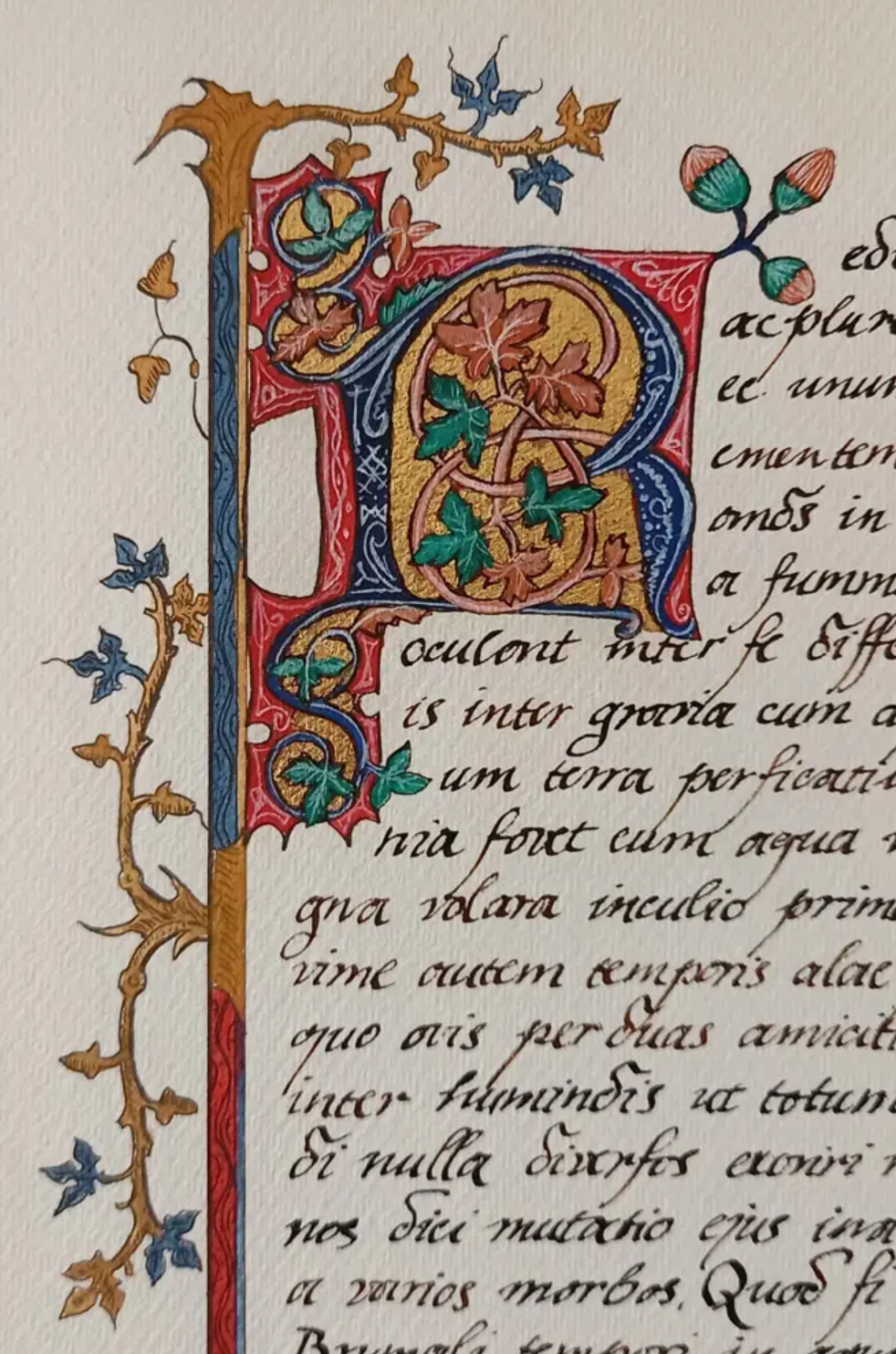
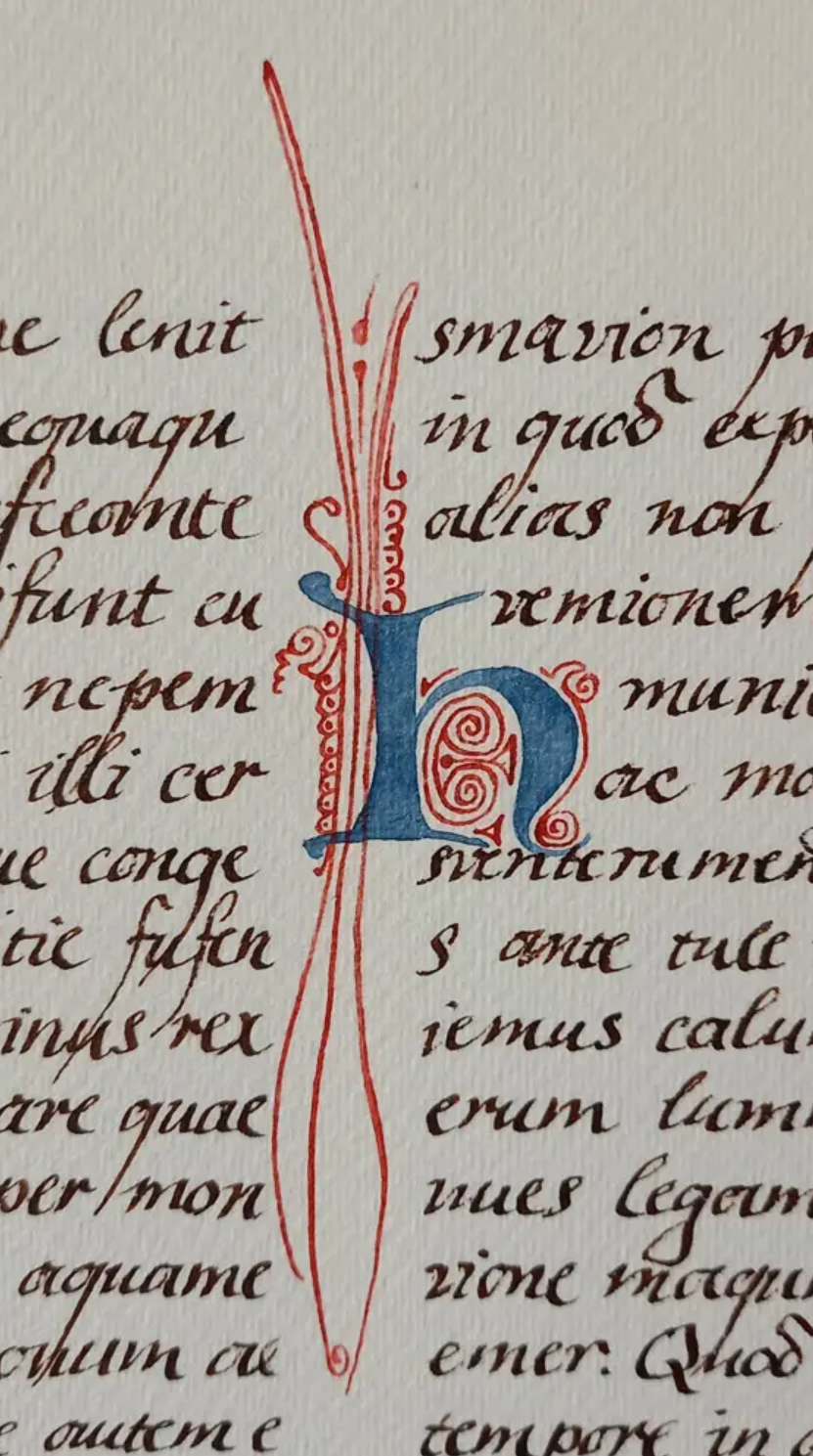
Other props
On her Instagram, Veronika shows off some of the props that she helped create that went unused or unseen in the final film. My favourite is definitely this triangle notebook - Veronika "was handed this beautifully bound triangular notebook to fill it with different scripts and drawings, which I enjoyed immensely while admiring the notebook's form" (X). There's lots of really tasty scripts in here, and one of them definitely seems to draw on Enochian. I'm very taken by the one that seems to be some sort of ancient kanji.
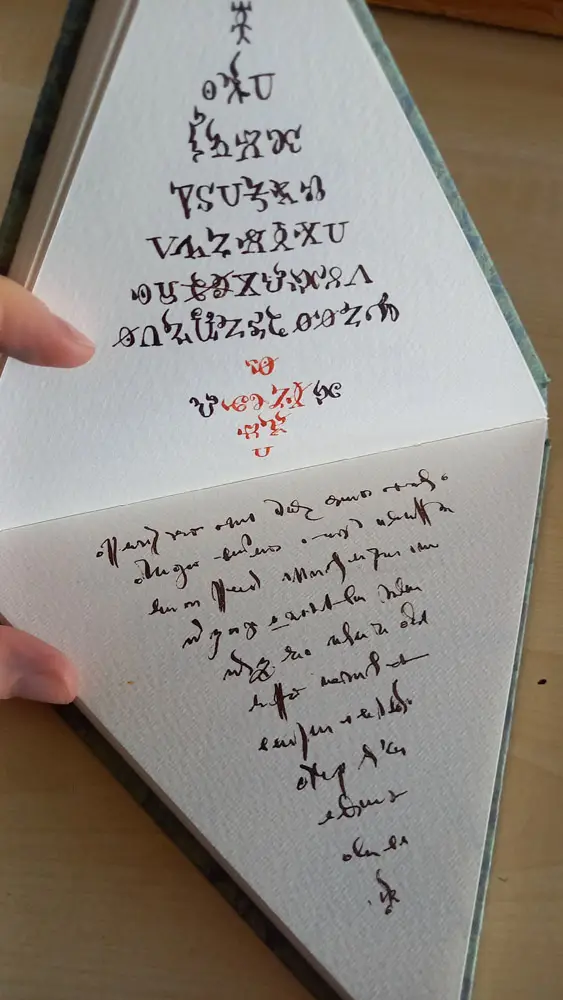
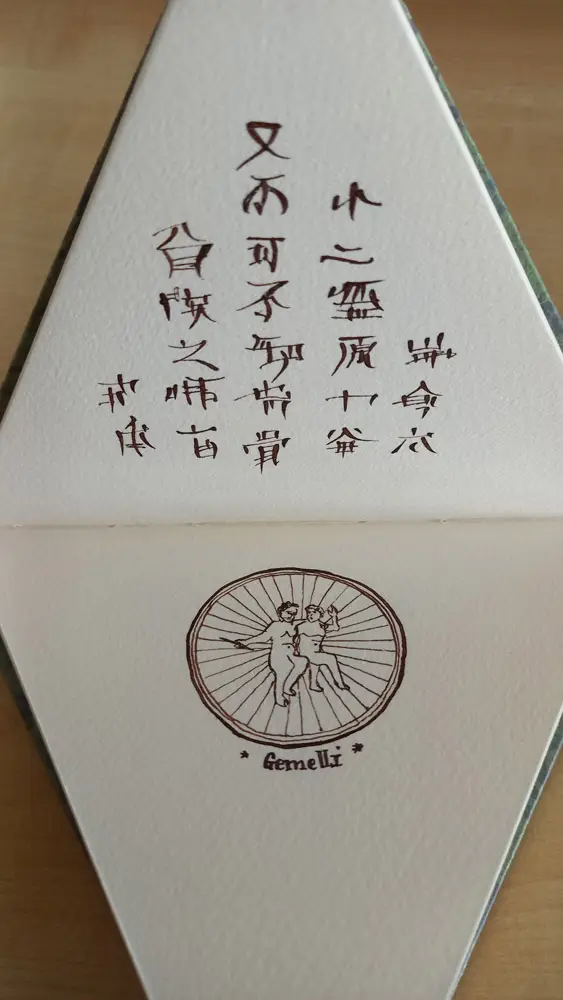
There are more examples of props on Veronika's website!